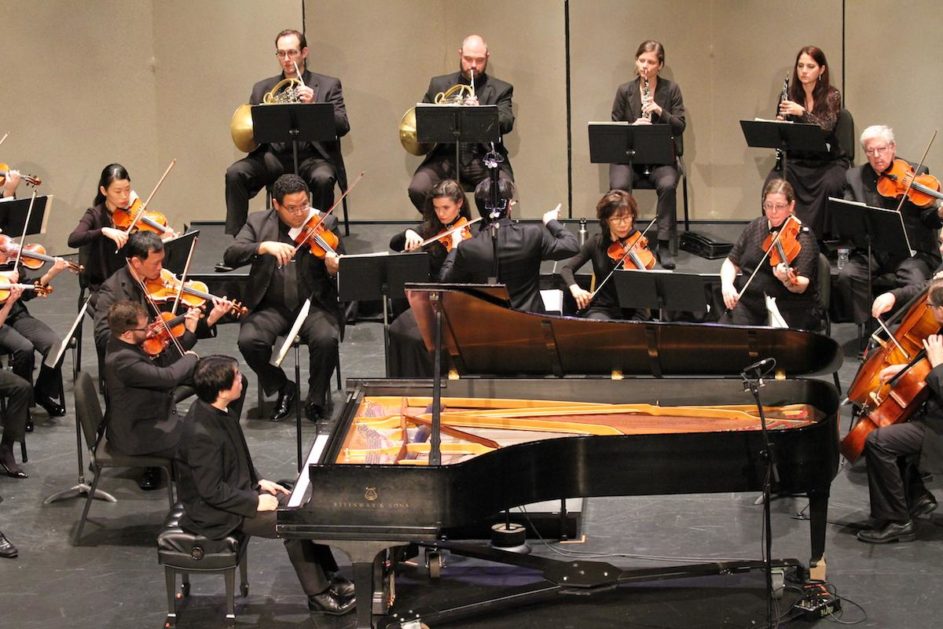Knowing that Edward Elgar’s “Serenade for Strings in E Minor,” Op. 20, which opened the Knoxville Symphony Chamber Classics concert Sunday at the Bijou Theatre, was first performed by 35-year-old Elgar himself conducting the Worchester Ladies’ Orchestral Class in 1892, the year it was written, tells the story of what this music might be about.
The opening movement, marked “Allegro piacevole” (“pleasant and fairly quick”) – with its charming romanticism, the feel of an English ballad and delightful little harmonic leaps – must certainly have charmed the ladies, as it seemed to do the audience on Sunday afternoon.
The second, slower movement was less about a sense of countryside and more about folding and unfolding a melody, making new discoveries each time, with its ascending and falling patterns. The third movement picked up the pace again to take another look at the material in the opening section, but also inventing on it, with prominent bass underpinning.
The second piece on the program, Mozart’s “Piano Concerto No. 9 in E-Flat Major,” K. 271, was written when Mozart was 21, probably the maturity equivalent in 18th-century terms of lifespan to Elgar’s 35. This concerto is considered the first of Mozart’s mature works. He died at 35.
The concerto has long been known as the “Jeunehomme” (“Young Man”) concerto, a misnomer used by many biographers. It was actually dedicated to Victoire Jenamy, the young daughter of the dancer and choreographer Jean-George Noverre, with whom Mozart was working at the time.

Pianist Chih-Long Hu performs Mozart.
Pianist Chih-Long Hu was a pure joy to hear playing the concerto. His style of playing perfectly fit the Baroque/Classical era of the piece, without any of the sustain-pedal sound blending that came in later Romantic music.
In the opening movement, “Allegro” (“fairly quick”), Hu played fluid arpeggios and trills, with bouncy lightness in the right hand and quieter, lower left-hand voices providing support. The second movement, “Andantino” (“slightly faster than a slow walking pace”), was darker and more emotional. At moments it had operatic drama.
The third movement took off with a flourish, with its light, playful, almost galloping piano solo sections, in the middle of which Mozart stuck a surprising minuet dance.
Hu was nothing short of brilliant throughout. His playing is crisp and never muddy or lumpy, even in the lightning-fast arpeggios and trills.
Then, to prove his approach to playing wasn’t limited to Mozart, Hu played an equally delightful encore of Franz Liszt’s “La Campanella” (“The Little Bell”), based on a melody taken from the great violin virtuoso Niccolò Paganini. Its tinkling bell sounds involve little jumps played on the highest notes on the piano at 1/16th-note speed.
Tchaikovsky’s “Souvenir de Florence, String Sextet in D Minor,” Op. 70, written in 1890, brought the concert to a rewarding close.
Tchaikovsky loved the Italian folk music he heard everywhere in Rome during his visit there during the winter of 1879. He also loved the freedom from scrutiny of his private life and the constraints he had to live under in Russia.
The piece started out like someone in a rush, excitedly telling a story. Its melodies were filled with sunlight. Then it slowed down to a light, breezy melody played in the first violins. There was a beautiful, almost romantic solo played by concertmaster William Shaub before Andy Bryenton’s cello joined for a duet. Later the role was reversed, with the cello taking the solo lead and Shaub’s violin joining in; all the while the other strings play pizzicato accompaniment.
More about the Knoxville Symphony’s concerts, including Saturday night’s (March 9) Pops concert, featuring the music of Pink Floyd, can be found here.

